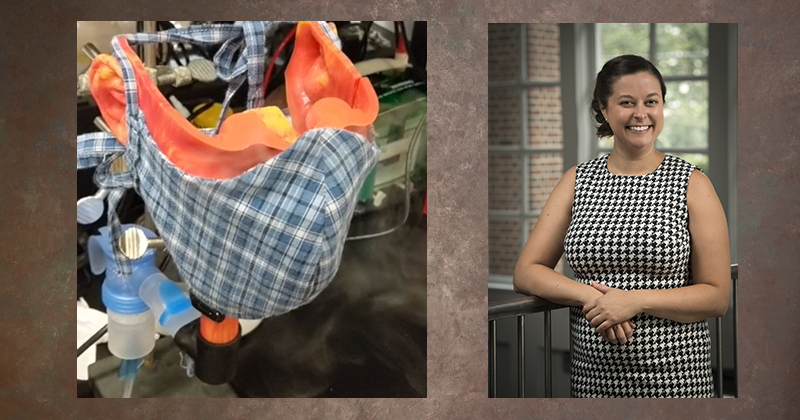


Face mask fit matters
Photos courtesy of Cathy Fromen December 18, 2020
Fit is important, but an imperfect mask is still better than none, UD researchers find
When you wear a mask in the fight against the coronavirus (COVID-19), you protect others around you by keeping your exhalations, known as aerosols, and many of the potentially infectious particles within them, to yourself.
A University of Delaware research team developed a novel method for evaluating how well face masks keep aerosols in, finding that tightly fitting N95 respirator masks are more protective than loose-fitting N95 masks, surgical masks and sewn masks. However, even an imperfectly fitting mask is better than none at all. What’s more, for homemade masks, a few simple tweaks — layering in a coffee filter and using a pipe cleaner to reduce the gap around the nose — could enhance your protection.
The results were published Dec. 16 in PLOS One. The research group led by Cathy Fromen, assistant professor of chemical engineering, includes graduate students Emily Kolewe, Zach Stillman and Ian Woodward.
A new approach to mask research
Since COVID-19 struck, face masks have become a hot new research topic around the world. Most research focuses on material characterization and efficiency. Fromen’s group set out to study aerosol transmission from the gaps around the sides, bottom and nose area of masks.
The group created an in vitro model to quantify particle transmission using a nebulizer, or a device that generates inhalable mists of medicine for diseases such as asthma, and a 3D printed replica of a face, nose and mouth.
The team found that tightly fitting N95 respirators are the best-performing face masks, which suggests that these masks should be prioritized for healthcare workers who will be fit-tested for them. In comparison, loosely fitting N95 masks, surgical masks and sewn masks all allowed 35-70-fold more particles to be released.
The team found that a few upgrades to sewn facemasks made them more protective. Placing a coffee filter between layers of cotton fabric or using a pipe cleaner to make a nose grip reduced the particle counts that escaped from these homemade masks.
The team measured not only the number of aerosols but also the average particle size that can escape the facemask. They find that wearing a mask resulted in a larger average aerosol size escaping at the gaps, which means masks are both effectively filtering the smallest aerosols and also creating a condition inside the mask that allows aerosols to grow.
“Think of what happens when your glasses fog up when wearing a mask; all of that humidity inside your mask helps exhaled aerosols grow larger,” said Fromen. “Bigger aerosols don’t stay suspended in the room as long as smaller ones and we think this shows an added bonus for wearing a facemask.”
While masks that fit well without gaps are most protective, even poorly fitted masks likely reduce transmission of aerosols, or exhaled particles. However, if worn in areas with poor ventilation, the aerosols that escape from poorly fitting masks could still build up to enough to promote COVID-19 transmission. That’s just another reason to combine face mask usage with social distancing and proper ventilation.
Contact Us
Have a UDaily story idea?
Contact us at ocm@udel.edu
Members of the press
Contact us at 302-831-NEWS or visit the Media Relations website

